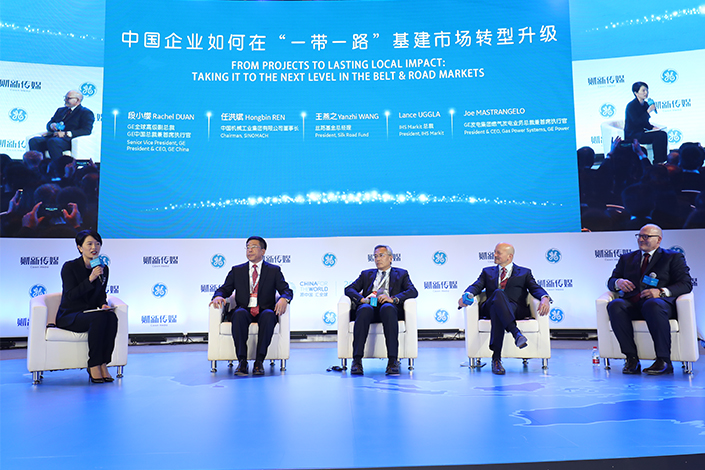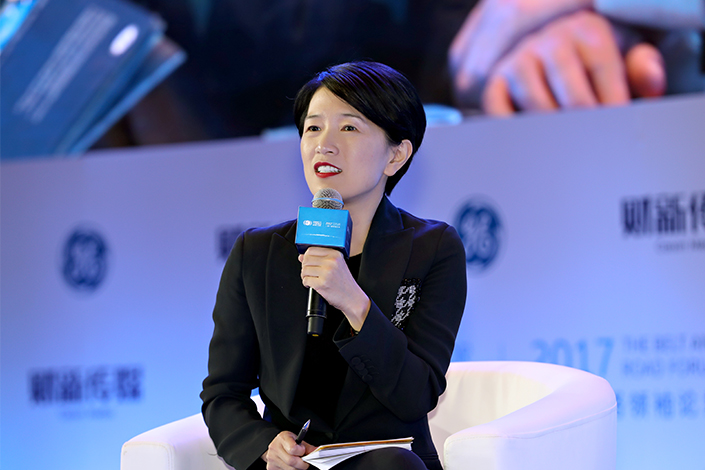2017 “China for the World” Belt & Road Forum Opens in Beijing New Era, New Practices – Taking It to the Next Level along the “Belt and Road”
 |
BEIJING, CHINA – November 2, 2017 – The 2017 “China for the World” Belt & Road Forum, co-hosted by GE and Caixin Media, was held in Beijing today. Nearly 800 experts from across the infrastructure industry ecosystem gathered to network, share insights and opportunities, and explore how to make a lasting impact in Belt and Road markets. Now in its fourth year, the GE-Caixin forum is China’s first private-sector forum focusing on supporting Chinese infrastructure companies going global in Belt and Road markets – and with guests including government officials, Chinese infrastructure company representatives, project end-users, and financiers, it provides a comprehensive view of the Belt and Road ecosystem.
With Belt and Road now encompassing almost all lines of business, an increasing number of companies are including the initiative as part of their growth strategies. It is Chinese EPC (Engineering, Procurement, and Construction) companies, however, that have been pioneers in taking on infrastructure projects such as roads, ports, and power plants in Belt and Road markets for well over 20 years, and they represent part of the first wave of Chinese companies going global. Now, expanding policy and financing support from the Chinese government, along with ensuing support from the private sector, are ushering in an unprecedented new era of growth for Chinese companies in Belt and Road countries. Many of these companies are moving beyond project contracts to thinking about their long-term strategies and the local impact they want to create in Belt and Road markets.
“As a multinational company with presence in more than 180 countries, and a partner of Chinese companies going global for more than 20 years, our experiences have helped us to develop a robust knowledge of the various political, financial, and operational issues that come with developing international infrastructure projects, as well as the nuanced differences between regions and industries,” said Rachel Duan, Senior Vice President of GE, President and CEO of GE China. “This knowledge, combined with our global network and financing capabilities, has left us well-positioned to contribute to new models of cooperation, tackle evolving challenges, and create win-win scenarios by working with all parties involved in today’s Belt and Road environment, which is why we continue to host this forum.”
New Challenges, New Models
Since the Belt and Road Initiative was launched four years ago, over 100 countries and international institutes have pledged support and gotten involved in growing the markets along the Belt and Road, with many landmark projects successfully completed or underway. Total trade between China and Belt and Road markets amounted to USD 3 trillion between 2014 and 2016. However, delegates at this year’s forum agree that Chinese companies still face many challenges as they aspire to drive sustainable growth in destination markets.
 |
“As pilots along the Belt and Road, Chinese EPCs are now facing various challenges including international competition, geopolitical risks, financing, and conflicts of culture,” said Hongbin Ren, Chairman of Sinomach. “With the increasing difficulty and complexity of infrastructure projects along the Belt and Road, almost all projects require inter-region, inter-company, and inter-industry cooperation. These challenges require all Chinese EPCs to be more open-minded to collaboration with various parties, instead of operating under a zero-sum mentality. We must continuously innovate our models when ‘going global’ so that we can grow in the long term while bringing real benefits to Belt and Road countries.”
Responding to the need for evolving business models for Belt and Road projects, the three strategies of “joint market development, joint financing, and joint operation,” were outlined in the forum, replacing the previous bundle-tender model in which EPC enterprises subcontracted bids to ‘suppliers.’
• Joint Market Development: To effectively win along Belt and Road, Chinese EPCs and partners must work together to develop potential markets ahead of project entry, in order to avoid a mismatch between demand and real projects, and to ensure that projects will generate long-term benefits for local markets. Efforts at market development include dedicated research into local markets’ energy ecosystems, existing infrastructure, and active proposals for how to best benefit end-users.
• Joint Financing: Infrastructure projects usually require a large amount of investment so steep that financing requirements are rather prevalent. Traditional government loans are far from meeting Chinese EPCs’ needs. Enterprises must be able to tap into capital markets in China and at the same time share global financing resources.
• Joint Operation: Beyond just building infrastructure along the Belt and Road, Chinese EPCs are increasingly encouraged to partake in operations of new facilities. Joint operation further increases the chances of successful financing, as lenders are more inclined to support projects in which EPCs take an increased stake following construction.
New Practices
Beyond offering an opportunity to discuss new challenges and models for cooperation, the 2017 “China for the World” Belt & Road Forum provided a platform for enterprises to forge new agreements and put the models into practice. Several such agreements were finalized with announcements at this year’s event.
GE and PowerChina showcased new efforts in market development by publishing an in-depth market report on Nigeria’s grid system, in response to challenges identified by the two companies in powering the country. In April 2017, GE and PowerChina had discovered that many power plant projects were being shelved due to the fact that Nigeria’s grid infrastructure was insufficient to deliver power to end-users. After half-a-year's analysis and research on the market, GE and PowerChina released a report providing a deep-dive into key reasons for blackouts and load shedding, as well as a proposal for how to build a more effective grid system. The report represents a shift toward more proactive market development efforts to ensure that projects along the Belt and Road not only solve their primary goals of generating power at the source, but also provide a long-sighted view of benefits for end-users and effectively distribute power according to the country’s energy needs.
In a similar market development effort, GE, together with China Energy Engineering Corporation (CEEC), published a report on the state of the power market in Vietnam, following a new strategic MOU between the two companies. The report provides a detailed analysis of Vietnam's resource endowments, energy structures, electricity market development and EPC competition. In view of Vietnam's future energy-based thermal power development planning – as well as the local market for capital, environmental protection, technology and quality requirements – the report explores the new models of resource allocation and cooperation between China EPCs and foreign technology enterprises like GE to enhance market development. The models aim to provide early identification of short-term and mid-term projects with co-investment and financing, representing a first-of-its-kind initiative between GE and an EPC partner. Both companies further committed to integrating business units to provide synergy – by optimizing projects, risk prevention, competitive advantages, and financing – to achieve long-term win-win scenarios.
In capturing Belt and Road opportunities, GE has been continuously strengthening its partnerships with Chinese EPCs. GE and PowerChina agreed to a strategic design framework to strengthen and expand their longtime global energy ecosystem cooperation, which already covers over 20 countries worldwide. The outcome-oriented three-year plan covers fast track, SPS and grid, as well as renewables including hydro and wind. It is the first such agreement covering all of GE’s energy-related businesses. Also covered in the agreement are arrangements for project management and troubleshooting, debt and equity financing for new projects, and training on how to best leverage digital efficiencies.
Moving Forward to Generate Lasting Local Impact
Delegates at this year’s forum agree that the Belt and Road Initiative reflects the common goals of countries along the routes. They also agree that going forward, the evolving market dynamics of Belt and Road will require Chinese companies to focus on how to address local stakeholder concerns in order to maintain the sustainable development of projects along the route. These concerns include the need to create long term social impact by ensuring that projects help to generate economic growth; to develop local talent by employing local workers; and to be environmentally conscious throughout the project cycle. Attention to such issues will create what are truly win-win situations.
Case studies presented at the forum helped model the paths forward. For instance, the HUBCO power plant in Pakistan, developed in partnership with GE and CEEC, will be able to supply electricity for 4 million families and make a significant contribution to Pakistan’s ambitious national target of increasing its electricity coverage from 67% to 90% by 2025, generating lasting social and economic impact while meeting government concerns. Meanwhile, the strategies of “joint market development,” “joint financing,” and “joint operation,” outlined in the forum help to provide a model for companies who can evaluate and address local concerns in the market development phase, and execute on those concerns through effective financing, project management, and operation.
About GE:
GE (NYSE: GE) is the world’s Digital Industrial Company, transforming industry with software-defined machines and solutions that are connected, responsive and predictive. GE is organized around a global exchange of knowledge, the "GE Store," through which each business shares and accesses the same technology, markets, structure and intellect. Each invention further fuels innovation and application across our industrial sectors. With people, services, technology and scale, GE delivers better outcomes for customers by speaking the language of industry. www.ge.com


